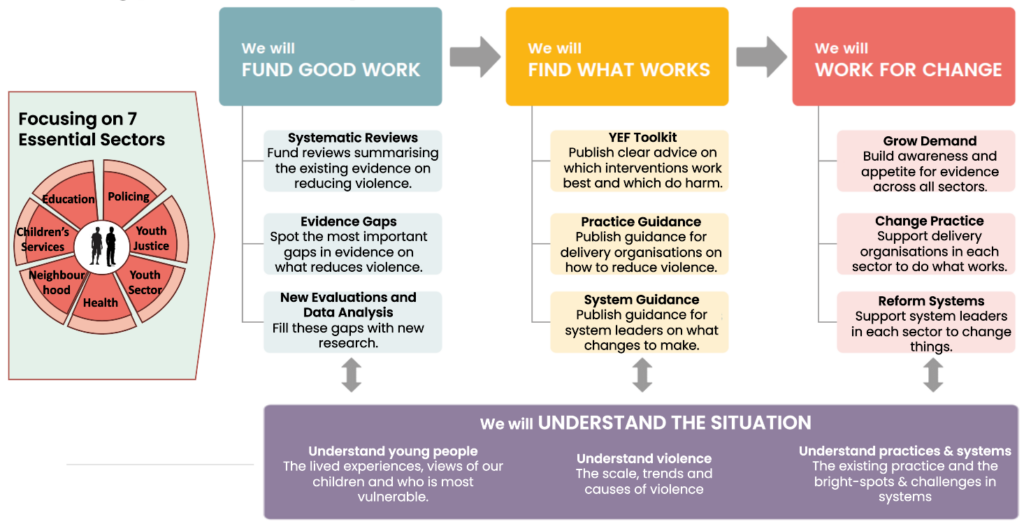Our strategy – how we’ll deliver on our mission
The Youth Endowment Fund is a charity with a mission that matters – we’re here to prevent children and young people becoming involved in violence. Through our strategy, we do this by finding out what works and building a movement to put this knowledge into practice.
How we’re working to prevent youth violence
To make a lasting difference we must do more than just fund and evaluate promising programmes to prevent youth violence. We have to make change happen – changing policy and practice – so that children are better supported and violence reduces.
The graphic below illustrates our strategy, showing you what we do to deliver on our mission. You can find a more detailed description below.

Focusing on seven essential sectors
The first step in our strategy is to focus on seven sectors where we’ll prioritise our funding and research – this is where we believe we’re more likely to deliver change. It’s our belief that these areas will have the biggest impact to improve support for young people at risk of becoming involved in crime and violence.
The seven sectors are:
We will fund good work
The second step of our strategy is to fund great research. All our funding is done to build a better understanding of what works to reduce youth violence. We do this in three ways:
1. Systematic reviews
We will fund reviews of existing research on reducing violence, that use explicit, accountable and rigorous research methods.
2. Evidence gaps
To keep children safe, we need to make sure they’re getting the best possible support. Right now, this is difficult to do because we simply don’t know enough about which approaches are most effective.
Our Evidence and Gap Maps are one step towards changing this. By mapping the evidence and identifying where there are gaps, we’ll be able to focus research in areas that build our understanding of what works to protect children from violence. It also helps us to see where there’s lots of high quality evidence, which we’ll make easily accessible through our YEF Toolkit.
3. New evaluation and data analysis
We publish an independent report for every evaluation that we fund. This tells everyone whether that project was an effective way to reduce youth crime and violence, and helps us understand what projects work, for whom and why.
We will find what works
It’s essential that we bring all of this research together and make it accessible for everyone to understand what works to reduce youth violence. We do this in three ways:
1. YEF Toolkit
The YEF Toolkit summarises the best available research about different approaches to preventing serious youth violence. It gives you the ‘best bets’, telling you how effective each approach is likely to be, how confident you can be in the evidence and provides indicative costings. We’ll continue to update the Toolkit regularly with new approaches and the latest evidence.
2. Guidance reports
We’ll produce a guidance report for all of our priority sectors. Each report combines a summary of all our research with the voices of young people and practitioners. It’ll include five to ten recommended changes to policy and practice, so that – together- we can reduce violence. We will produce two sets of guidance:
- Practice Guidance: for delivery organisations on how to reduce violence.
- System Guidance: for system leaders on what changes to make.
We will work for change
The next step in our strategy is to put the evidence of what works to prevent youth violence into action. But we know we can’t do this alone. To improve support for children and young people, we need to change policies and practice. We do this in three ways:
1. Grow demand
Evidence about what works to prevent youth violence is often hard to find, hard to access and hard to understand. If we want people to use evidence when they’re making decisions about how best to protect and support young people, this needs to change. To help, we’ve gone beyond creating easy-to-read summaries of research – we actively work with professional networks to run trainings, events and talks. That way, we can promote what works and connect professionals with best practice from around the country.
2. Change practice
In each of the sectors we’re focusing on, we’ll bring together people who are passionate about protecting children from harm – from frontline practitioners and commissioners to academics and policy makers. We’ll work together to examine the evidence and identify what needs to change. We’ll use our collective experience and influence to push for improvements in the practices, policies and systems which impact how, when and why children are supported.
3. Reform systems
We work closely with government officials and ministers to ensure that they have the best information to make decisions that affect children. We share our work with the media, so that it informs the public debate about how we reduce violence permanently.
We will understand the situation
Finally, we need to understand the context of what’s happening now in the lives of young people. We have several ways of doing this, which include:
1. Understand young people
Children and young people are at the heart of our mission. We fund work to understand their lives, the impact of violence and what works to change this. Key parts of this work are
- The Peer Action Collective – the largest peer research project on youth violence in the UK;
- Our annual Children, violence and vulnerability report, which explores the ways in which violence – and fear of violence – affects children’s lives.
- We’ve also established a Youth Advisory Board to help shape decisions and influence how and where we spend our funding.
2. Understand violence
We will conduct data analysis of the trends in youth violence including the scale, trends and causes of violence.
